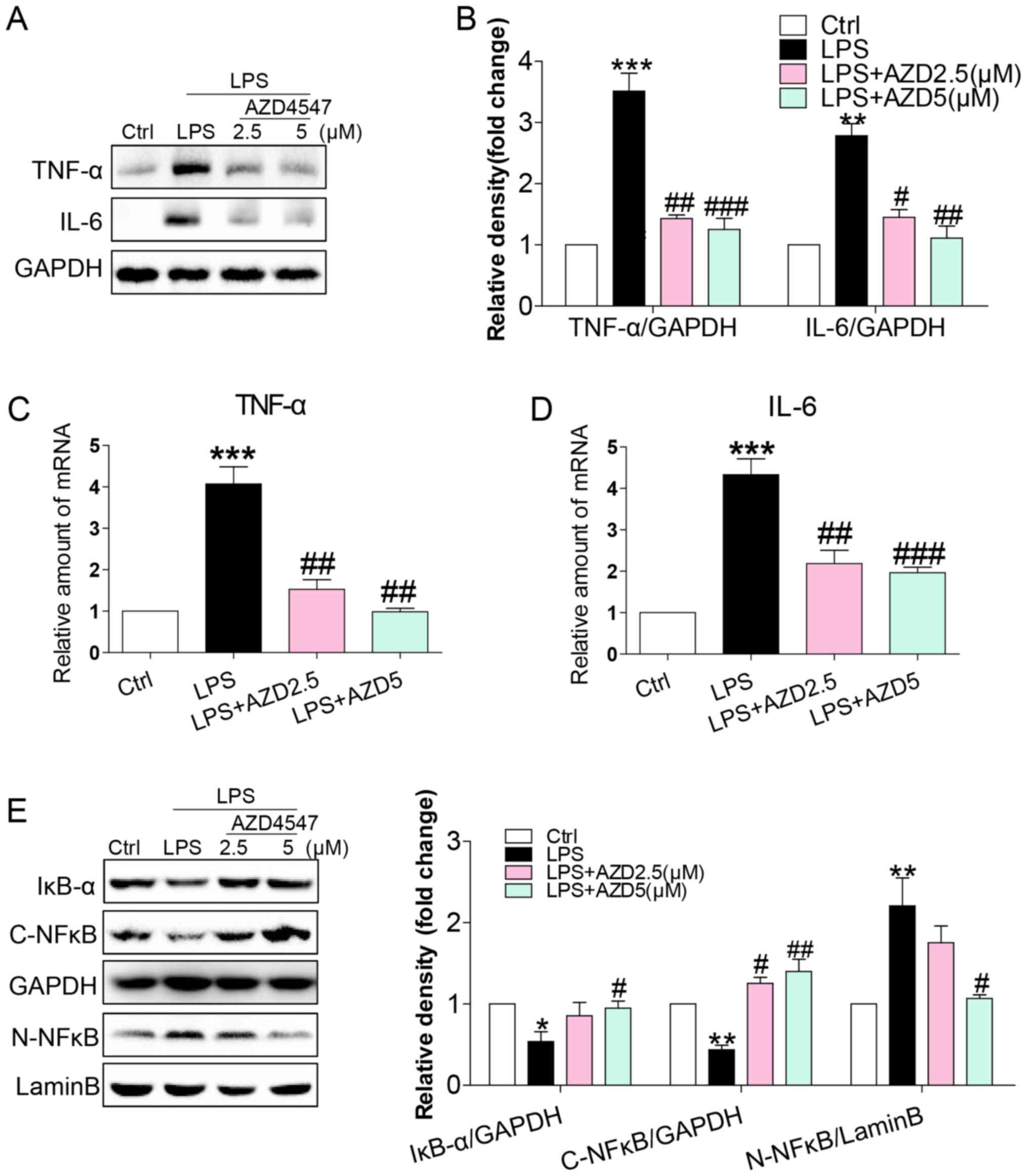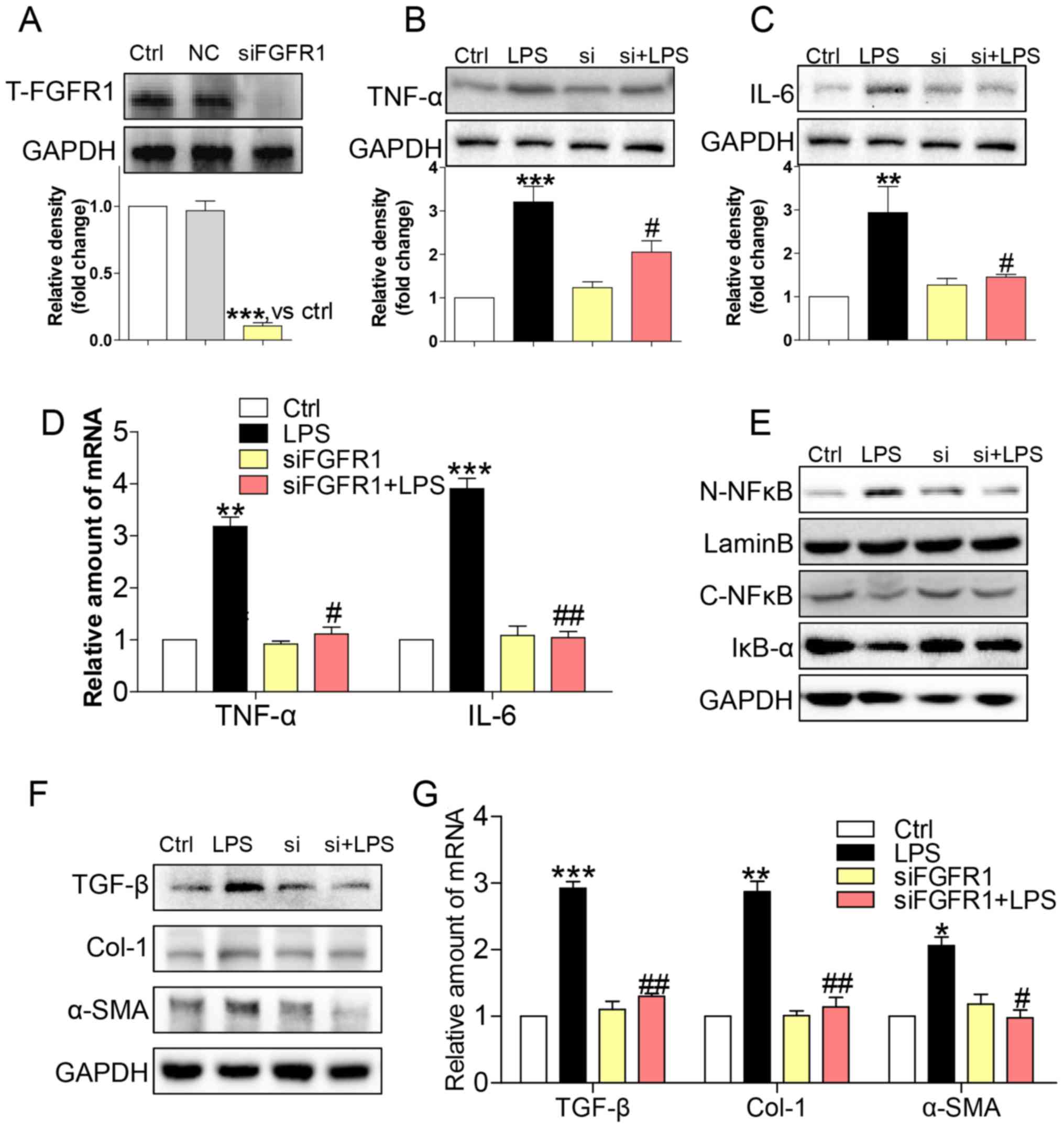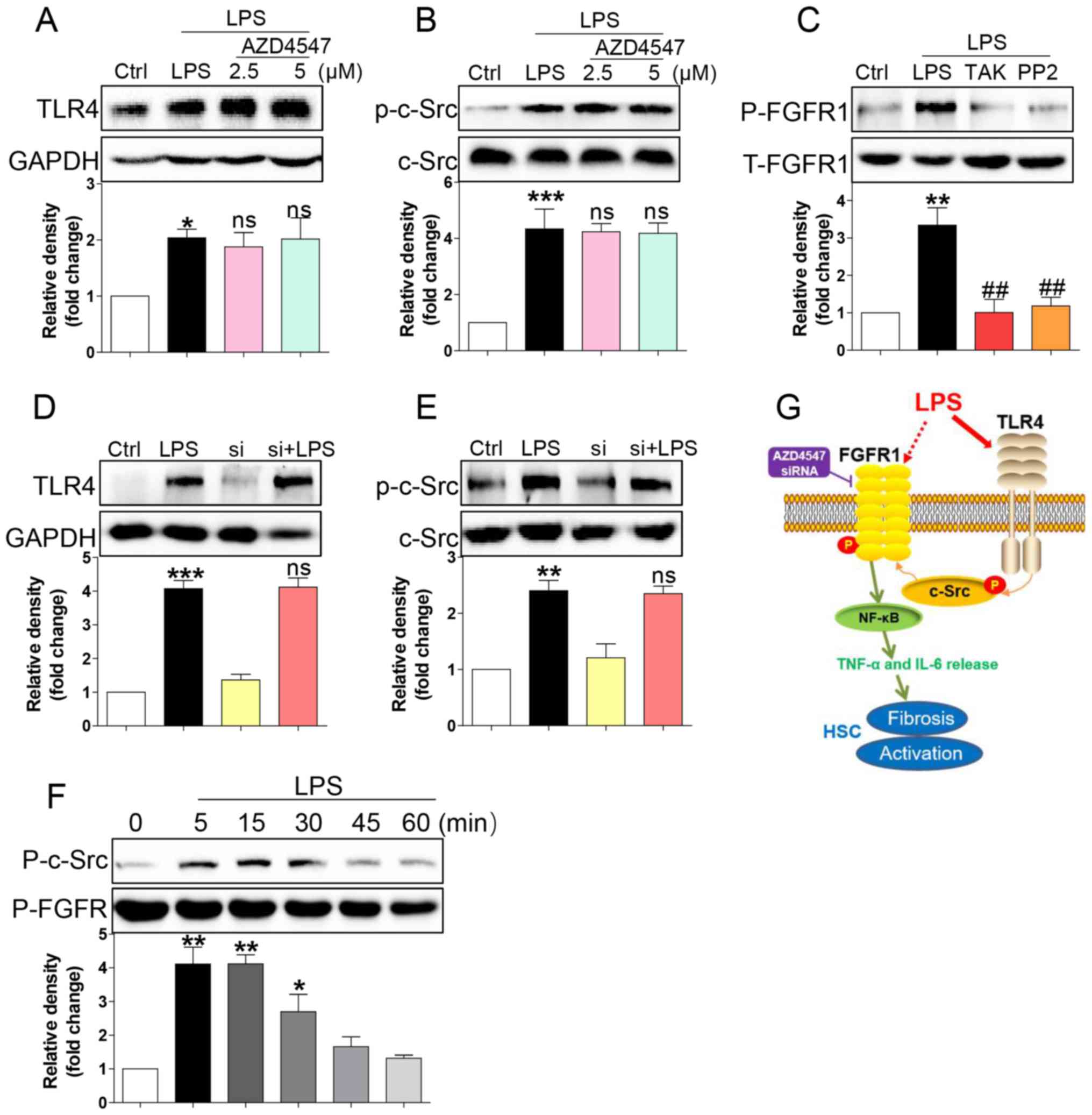|
1
|
Koyama Y and Brenner DA: Liver
inflammation and fibrosis. J Clin Invest. 127:55–64. 2017.
View Article : Google Scholar : PubMed/NCBI
|
|
2
|
Schuppan D and Kim YO: Evolving therapies
for liver fibrosis. J Clin Invest. 123:1887–1901. 2013. View Article : Google Scholar : PubMed/NCBI
|
|
3
|
Gu L, Tao X, Xu Y, Han X, Qi Y, Xu L, Yin
L and Peng J: Dioscin alleviates BDL- and DMN-induced hepatic
fibrosis via Sirt1/Nrf2-mediated inhibition of p38 MAPK pathway.
Toxicol Appl Pharmacol. 292:19–29. 2016. View Article : Google Scholar : PubMed/NCBI
|
|
4
|
Xu L, Yin L, Tao X, Qi Y, Han X, Xu Y,
Song S, Li L, Sun P and Peng J: Dioscin, a potent ITGA5 inhibitor,
reduces the synthesis of collagen against liver fibrosis: Insights
from SILAC-based proteomics analysis. Food Chem Toxicol.
107:318–328. 2017. View Article : Google Scholar : PubMed/NCBI
|
|
5
|
Zhang X, Han X, Yin L, Xu L, Qi Y, Xu Y,
Sun H, Lin Y, Liu K and Peng J: Potent effects of dioscin against
liver fibrosis. Sci Rep. 5:97132015. View Article : Google Scholar : PubMed/NCBI
|
|
6
|
Yin C, Evason KJ, Asahina K and Stainier
DY: Hepatic stellate cells in liver development, regeneration, and
cancer. J Clin Invest. 123:1902–1910. 2013. View Article : Google Scholar : PubMed/NCBI
|
|
7
|
Yin L, Qi Y, Xu Y, Xu L, Han X, Tao X,
Song S and Peng J: Dioscin inhibits HSC-T6 cell migration via
adjusting SDC-4 expression: Insights from iTRAQ-based quantitative
proteomics. Front Pharmacol. 8:6652017. View Article : Google Scholar : PubMed/NCBI
|
|
8
|
Fouts DE, Torralba M, Nelson KE, Brenner
DA and Schnabl B: Bacterial translocation and changes in the
intestinal microbiome in mouse models of liver disease. J Hepatol.
56:1283–1292. 2012. View Article : Google Scholar : PubMed/NCBI
|
|
9
|
Hedayat M, Netea MG and Rezaei N:
Targeting of Toll-like receptors: A decade of progress in combating
infectious diseases. Lancet Infect Dis. 11:702–712. 2011.
View Article : Google Scholar : PubMed/NCBI
|
|
10
|
Oakley F, Meso M, Iredale JP, Green K,
Marek CJ, Zhou X, May MJ, Millward-Sadler H, Wright MC and Mann DA:
Inhibition of inhibitor of kappaB kinases stimulates hepatic
stellate cell apoptosis and accelerated recovery from rat liver
fibrosis. Gastroenterology. 128:108–120. 2005. View Article : Google Scholar : PubMed/NCBI
|
|
11
|
Mohammadi M, Olsen SK and Ibrahimi OA:
Structural basis for fibroblast growth factor receptor activation.
Cytokine Growth Factor Rev. 16:107–137. 2005. View Article : Google Scholar : PubMed/NCBI
|
|
12
|
Fischer H, Taylor N, Allerstorfer S,
Grusch M, Sonvilla G, Holzmann K, Setinek U, Elbling L, Cantonati
H, Grasl-Kraupp B, et al: Fibroblast growth factor
receptor-mediated signals contribute to the malignant phenotype of
non-small cell lung cancer cells: Therapeutic implications and
synergism with epidermal growth factor receptor inhibition. Mol
Cancer Ther. 7:3408–3419. 2008. View Article : Google Scholar : PubMed/NCBI
|
|
13
|
Böhm F, Speicher T, Hellerbrand C, Dickson
C, Partanen JM, Ornitz DM and Werner S: FGF receptors 1 and 2
control chemically induced injury and compound detoxification in
regenerating livers of mice. Gastroenterology. 139:1385–1396. 2010.
View Article : Google Scholar : PubMed/NCBI
|
|
14
|
Lin N, Chen S, Pan W, Xu L, Hu K and Xu R:
NP603, a novel and potent inhibitor of FGFR1 tyrosine kinase,
inhibits hepatic stellate cell proliferation and ameliorates
hepatic fibrosis in rats. Am J Physiol Cell Physiol. 301:C469–C477.
2011. View Article : Google Scholar : PubMed/NCBI
|
|
15
|
Riehle KJ, Yeh MM, Yu JJ, Kenerson HL,
Harris WP, Park JO and Yeung RS: mTORC1 and FGFR1 signaling in
fibrolamellar hepatocellular carcinoma. Mod Pathol. 28:103–110.
2015. View Article : Google Scholar : PubMed/NCBI
|
|
16
|
Mederacke I, Dapito DH, Affò S, Uchinami H
and Schwabe RF: High-yield and high-purity isolation of hepatic
stellate cells from normal and fibrotic mouse livers. Nat Protoc.
10:305–315. 2015. View Article : Google Scholar : PubMed/NCBI
|
|
17
|
Tucker JA, Klein T, Breed J, Breeze AL,
Overman R, Phillips C and Norman RA: Structural insights into FGFR
kinase isoform selectivity: Diverse binding modes of AZD4547 and
ponatinib in complex with FGFR1 and FGFR4. Structure. 22:1764–1774.
2014. View Article : Google Scholar : PubMed/NCBI
|
|
18
|
Liu M, Xu Y, Han X, Yin L, Xu L, Qi Y,
Zhao Y, Liu K and Peng J: Dioscin alleviates alcoholic liver
fibrosis by attenuating hepatic stellate cell activation via the
TLR4/MyD88/NF-κB signaling pathway. Sci Rep. 5:180382015.
View Article : Google Scholar : PubMed/NCBI
|
|
19
|
Pinzani M and Marra F: Cytokine receptors
and signaling in hepatic stellate cells. Semin Liver Dis.
21:397–416. 2001. View Article : Google Scholar : PubMed/NCBI
|
|
20
|
Ceccarelli S, Panera N, Mina M, Gnani D,
De Stefanis C, Crudele A, Rychlicki C, Petrini S, Bruscalupi G,
Agostinelli L, et al: LPS-induced TNF-α factor mediates
pro-inflammatory and pro-fibrogenic pattern in non-alcoholic fatty
liver disease. Oncotarget. 6:41434–41452. 2015. View Article : Google Scholar : PubMed/NCBI
|
|
21
|
Qi M, Yin L, Xu L, Tao X, Qi Y, Han X,
Wang C, Xu Y, Sun H, Liu K and Peng J: Dioscin alleviates
lipopolysaccharide-induced inflammatory kidney injury via the
microRNA let-7i/TLR4/MyD88 signaling pathway. Pharmacol Res.
111:509–522. 2016. View Article : Google Scholar : PubMed/NCBI
|
|
22
|
Qi M, Zheng L, Qi Y, Han X, Xu Y, Xu L,
Yin L, Wang C, Zhao Y, Sun H, et al: Dioscin attenuates renal
ischemia/reperfusion injury by inhibiting the TLR4/MyD88 signaling
pathway via up-regulation of HSP70. Pharmacol Res. 100:341–352.
2015. View Article : Google Scholar : PubMed/NCBI
|
|
23
|
Shan X, Zhang Y, Chen H, Dong L, Wu B, Xu
T, Hu J, Liu Z, Wang W, Wu L, et al: Inhibition of epidermal growth
factor receptor attenuates LPS-induced inflammation and acute lung
injury in rats. Oncotarget. 8:26648–26661. 2017. View Article : Google Scholar : PubMed/NCBI
|
|
24
|
Ren M, Qin H, Ren R, Tidwell J and Cowell
JK: Src activation plays an important key role in lymphomagenesis
induced by FGFR1 fusion kinases. Cancer Res. 71:7312–7322. 2011.
View Article : Google Scholar : PubMed/NCBI
|
|
25
|
Xiao C and Ghosh S: NF-kappaB, an
evolutionarily conserved mediator of immune and inflammatory
responses. Adv Exp Med Biol. 560:41–45. 2005. View Article : Google Scholar : PubMed/NCBI
|
|
26
|
Paik YH, Schwabe RF, Bataller R, Russo MP,
Jobin C and Brenner DA: Toll-like receptor 4 mediates inflammatory
signaling by bacterial lipopolysaccharide in human hepatic stellate
cells. Hepatology. 37:1043–1055. 2003. View Article : Google Scholar : PubMed/NCBI
|
|
27
|
Yao H, Hu C, Yin L, Tao X, Xu L, Qi Y, Han
X, Xu Y, Zhao Y, Wang C and Peng J: Dioscin reduces
lipopolysaccharide-induced inflammatory liver injury via regulating
TLR4/MyD88 signal pathway. Int Immunopharmacol. 36:132–141. 2016.
View Article : Google Scholar : PubMed/NCBI
|
|
28
|
Park S, Choi Y, Um SJ, Yoon SK and Park T:
Oleuropein attenuates hepatic steatosis induced by high-fat diet in
mice. J Hepatol. 54:984–993. 2011. View Article : Google Scholar : PubMed/NCBI
|
|
29
|
Zou L, Cao S, Kang N, Huebert RC and Shah
VH: Fibronectin induces endothelial cell migration through β1
integrin and Src-dependent phosphorylation of fibroblast growth
factor receptor-1 at tyrosines 653/654 and 766. J Biol Chem.
287:7190–7202. 2012. View Article : Google Scholar : PubMed/NCBI
|
|
30
|
Medvedev AE, Piao W, Shoenfelt J, Rhee SH,
Chen H, Basu S, Wahl LM, Fenton MJ and Vogel SN: Role of TLR4
tyrosine phosphorylation in signal transduction and endotoxin
tolerance. J Biol Chem. 282:16042–16053. 2007. View Article : Google Scholar : PubMed/NCBI
|













